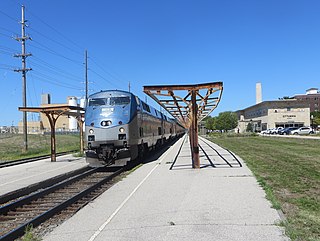
Ottumwa station is an Amtrak intercity train station in Ottumwa, Iowa, United States. The station was originally built by the Chicago, Burlington and Quincy Railroad, and has been listed as Burlington Depot by the National Register of Historic Places since November 26, 2008. It became a contributing property in the Historic Railroad District in 2011.
The Muscatine and Iowa City Railway was a short-lived railroad that leased several lines in southeastern Iowa in 1916 from the Chicago, Rock Island and Pacific Railway. Those lines had been built in the 1870s and 1880s by predecessors of the Rock Island, and were mostly abandoned in the 1970s.
Burlington Cedar Rapids and Northern Depot may refer to any railway station on the Burlington, Cedar Rapids and Northern Railway including:

The Burlington, Cedar Rapids and Northern Railway (BCR&N) was a railroad that operated in the United States from 1876 to 1903. It was formed to take over the operations of the bankrupt Burlington, Cedar Rapids and Minnesota Railway, which was, in turn, the result of merging several predecessor lines, the construction of which began in 1869. The corporate headquarters were in Cedar Rapids, Iowa, and it had operations in Iowa and in Minnesota. It was succeeded by the Chicago, Rock Island and Pacific Railway.
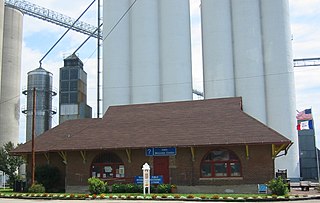
Burlington, Cedar Rapids & Northern Passenger Depot-Dows, also known as the Dows Rock Island Depot, is an historic building located in Dows, Iowa, United States. The depot was built in 1896 and served the Burlington, Cedar Rapids and Northern Railway as a combination passenger and freight station. The Romanesque Revival style was inspired by Henry Hobson Richardson's designs for small railroad stations. It was the first railway depot in Wright County. It passed to the Chicago, Rock Island and Pacific Railroad and continued to serve as a working depot until 1980. The Dows Historical Society bought and restored the depot in 1988. It now serves as a welcome center and railroad museum. It was listed on the National Register of Historic Places in 1993.
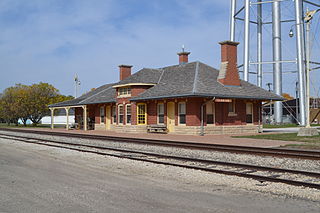
Burlington, Cedar Rapids and Northern Railroad Passenger Station, also known as Rock Island Railroad Depot and the Rock Island Depot Railroad Museum, is a historic building located in Clarion, Iowa, United States. The station was built in 1898 by contractor A. H. Connor & Company of Cedar Rapids, Iowa for the Burlington, Cedar Rapids and Northern Railroad (BCR&N). Clarion also had a Chicago Great Western Railway depot, no longer extant. At one time there were 14 trains that served the city. In 1903 the Chicago, Rock Island and Pacific Railway acquired the BCR&N, and this depot served that railroad. The single story, Romanesque Revival, brick structure measures 26 by 88.5 feet. It was added to the National Register of Historic Places in 1988.

The Rock Island Depot is a historic railroad station located at 201 East 10th Street in Sioux Falls, South Dakota. The station opened in 1886 to serve the Burlington, Cedar Rapids and Northern Railway, a predecessor of the Rock Island. The ashlar and wood building has a Richardsonian Romanesque design with a side-facing stone gable and an octagonal turret. The interior of the station includes a waiting room, a ticket office, and the station agent's quarters. As the railroad network spread through South Dakota, Sioux Falls became the state's primary commercial and transportation hub due to its established station. The station served passenger trains through Sioux Falls until 1970.

The Burlington, Cedar Rapids & Northern Freight House, also known as the Rock Island Freight House, is a historic building located in Burlington, Iowa, United States. It was listed on the National Register of Historic Places in 1983.
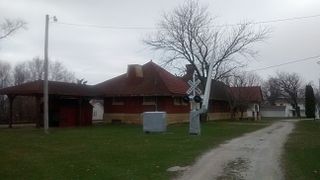
The Burlington, Cedar Rapids & Northern Passenger Station-Vinton, also known as Rock Island Depot and the Vinton Depot, is a historic building located in Vinton, Iowa, United States. Completed in 1900, this depot replaced a previous depot of the Burlington, Cedar Rapids and Northern Railway (BCR&N) located on the east side of town. It was designed by the railroad's architect and chief engineer, H.F. White, and built by A.H. Connor & Company of Cedar Rapids. The single-story brick structure was constructed on a limestone foundation. Three years after it was built, the BCR&N was acquired by the Chicago, Rock Island and Pacific Railroad. It continued to serve as a working depot until 1967. The Benton County Historical Society restored the depot and converted into a railroad museum. The building was listed on the National Register of Historic Places in 1990.

The Hawkeye Street Underpass is a historic structure located south of Nora Springs, Iowa, United States. It spans South Hawkeye Street for 28 feet (8.5 m). The Illinois Central Railroad arrived in Nora Springs in 1868, and the Burlington, Cedar Rapids & Northern Railway (BCR&N) arrived three years later. The later was acquired by the Chicago, Rock Island & Pacific Railroad in the early 1880s. This stone masonry arch underpass was constructed by the Rock Island Line in 1889 as part of an upgrade of the tracks. It was designed by F.A. McDonald who had worked for the BCR&N. It is the only known stone arch bridge in Floyd County. The bridge was listed on the National Register of Historic Places in 1998.

The Mills Tower Historic District is a nationally recognized historic district located in Iowa Falls, Iowa, United States. It was listed on the National Register of Historic Places in 1990. At the time of its nomination the district consisted of six resources, including two contributing buildings, and four non-contributing buildings. All of the buildings are associated with the Illinois Central Railroad (IC). The Dubuque & Sioux City Railroad, an affiliate of the IC, laid the first rail track to Iowa Falls in 1866. The following year the Iowa Falls & Sioux City Railroad, another IC affiliate, continued construction of the line to the west, and it reached Sioux City by 1870. The Burlington, Cedar Rapids and Northern Railway (BCR&N) by way of its affiliate the Cedar Rapids, Iowa Falls & North Western, entered Iowa Falls in 1880. Two years later it was expanded to the north and intersected with the IC main line, which required a controlled crossing. Little is known about this first crossing and what it contained.
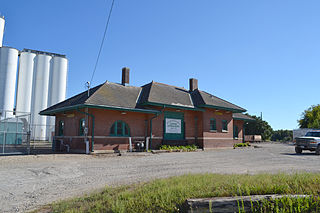
Iowa Falls Union Depot is a historic building located in Iowa Falls, Iowa, United States. The Dubuque & Sioux City Railroad, an affiliate of the Illinois Central Railroad (IC), laid the first rail track to Iowa Falls in 1866. The following year the Iowa Falls & Sioux City Railroad, another IC affiliate, continued construction of the line to the west, and it reached Sioux City by 1870. They built a plain, two-story frame depot to serve Iowa Falls. The Burlington, Cedar Rapids and Northern Railway (BCR&N) by way of its affiliate the Cedar Rapids, Iowa Falls & North Western, entered Iowa Falls in 1880. They built their own depot. It was basically another east–west route, but local business leaders desired a north–south route to serve the community.

The La Porte City Station, also known as the La Porte City Hall, is a historic building located in La Porte City, Iowa, United States. It was built as a depot for the Waterloo, Cedar Falls & Northern Railroad, an interurban system. The system began in 1885 as the Waterloo Street Railway Co., and grew to include routes to Cedar Falls (1897), Denver, Iowa (1901), and Waverly (1906). In 1912 it was expanded to Cedar Rapids, and this building was constructed at that time. It is a single-story, brick, Georgian Revival structure. It served as a depot until 1928, when it was replaced by a new building that was more freight focused rather than passenger focused as this depot was. This building was acquired by La Porte City at that time for use as a city hall. The community's public library was organized in 1945, and it was located here as well. The building was listed on the National Register of Historic Places in 1979. The library has subsequently been moved to a different building on Main Street.

The Chicago Great Western Railroad-Waterloo Freight Depot is a historic building located in Waterloo, Iowa, United States. In 1887 the Chicago, St. Paul & Kansas City Railroad (CSP&KC) was the third system to enter the city, after the Illinois Central (1870) and the Burlington, Cedar Rapids and Northern Railway (1876). The CSP&KC was the first of the three to put its depots in the downtown area. Initially it built two depots in Waterloo, one on the west side of the Cedar River and one on the east side. By 1892 it had built separate passenger and freight depots along East Sixth Street. That was the same year that the CSP&KC became known as the Chicago Great Western Railroad. In 1903 the railroad built new passenger and freight depots a block south, moving them closer to the city's wholesale houses. The two-story concrete block freight depot was built on a rough limestone foundation. It features round arch freight doors and a simple wood cornice. The concrete block addition on the southeast side replaced a frame gabled structure, but its construction date is unknown. The old brick passenger depot was torn down in 1973, and the freight depot was listed on the National Register of Historic Places in 1997. In 2001 the building, which is owned by the City of Waterloo, was leased to the University of Northern Iowa for its Center for Urban Education (UNI-CUE).

The Hawthorne Glove and Novelty Company–Shrader Drug Company Building is a historic building located in Iowa City, Iowa, United States. Completed in 1906, this utilitarian three-story brick structure is located in the city's original railroad and industrial corridor south of the central business district. This was an industrial area from the 1870s to the 1940s. It replaced a recently built building on the same site by the Hawthorne Glove and Novelty Company that had been destroyed in a fire. The back of the building opened upon the rail sidings of a branch line of the Burlington, Cedar Rapids and Northern Railway, later the Chicago, Rock Island and Pacific. By the start of World War I the Shrader Drug Company occupied the building. It was one of three drug related factories that were located along the South Gilbert Street corridor at that time. The company name changed to the Hewell-Shrader Drug Company in 1930 and then the Hewell-Shrader Company in 1945 after farm fertilizer was added to its product line. The company closed in 1956, and the building was sold to the Thompson Transfer and Storage Company who used it for a warehouse. Whipple House Furniture Store took over the building three years later, and remained until 1975. In the intervening years a variety of businesses occupied the building until the 1980s when it was vacant for a period of time. In the mid-1980s The Vine Tavern occupied the basement level and the upper floors were used for artist studios. In 2012 the upper floors were converted into apartments. The building was listed on the National Register of Historic Places in 2014.
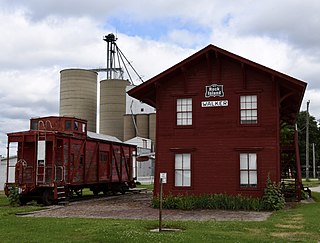
Walker Station is a historic building located in Walker, Iowa, United States. The two-story frame building with bracketed eaves was completed in 1873 along the Burlington, Cedar Rapids, and Minnesota Railway tracks. The depot also served its successor railroads: the Burlington, Cedar Rapids and Northern, and the Chicago, Rock Island and Pacific. Typical of many railroad towns in the Midwest, this is the first building that was built here and the town grew up around it. It is an example of a combination depot that was used for both passenger and freight usage in smaller communities. Because it has a ground level brick platform, service here was primary passenger and light freight service. A higher level of freight service would have required a raised platform.

The WCF & N Center Point Depot and Substation, also known as the Center Point Depot Museum, is a historic building located in Center Point, Iowa, United States. The Mission Revival building was constructed in 1914 by the Waterloo, Cedar Falls and Northern Railway, an interurban line that ran between the Waterloo – Cedar Falls area and Cedar Rapids. Passenger service ended here in 1956, and rail freight was discontinued in 1973. The station sat empty until it was renovated beginning in 1983. Other renovation projects were carried out 1998 to 1999 and 2013. The building was acquired by the Linn County Conservation Board in the early 1980s and turned into a museum and rest stop along the Cedar Valley Nature Trail, which follows the former rail bed. The building was listed on the National Register of Historic Places in 2018.

The Burlington and Northwestern Railway (B&NW) was a 3 ft narrow gauge railroad system in Iowa that operated during the late nineteenth and early twentieth centuries. It connected Burlington, Iowa with branches to Washington and Oskaloosa, Iowa. Incorporated in 1875 as the Burlington and Northwestern Narrow Gauge Railway Company, it began carrying traffic in 1876, when it also dropped 'narrow gauge' from its corporate name. The line reached Washington in 1880, operating over 52.5 miles (84.5 km) of track. In 1881, the Burlington and Western Railway Company, a subsidiary of the Chicago, Burlington and Quincy Railroad (CB&Q) was formed to connect the line to Oskaloosa, completed in 1883. For two decades, both lines were operated as a single system, until on June 20, 1902, the system was widened to standard gauge and the B&NW was adsorbed by the B&W. Later that year, the system was leased to the CB&Q, and in 1903, the entire system was deeded to the CB&Q.

The Ijem Avenue Commercial Historic District is a nationally recognized historic district located in Nichols, Iowa, United States. It was listed on the National Register of Historic Places in 2020. It is composed of 12 one and two-story commercial buildings that date from the late nineteenth to the mid-twentieth century. It also includes one modern infill building. Nichols is a small town in western Muscatine County and was an important railroad shipping point and market town from about 1885 to about 1920. It was located along the Burlington, Cedar Rapids and Northern Railway, which came to town in 1871, and the Muscatine and Western Railroad, which arrived two years later. The two railroads intersected on the west side of the central business district, and both were incorporated into the Chicago, Rock Island and Pacific Railroad in the 1880s. The brick commercial buildings in the historic district were built during this period of time. They are attached one and two-story brick structures. The oldest buildings reflect the Italianate style with their arched windows, while the later buildings reflect the Neolassical and Commercial styles.
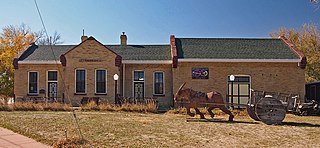
The Burlington Cedar Rapids and Northern Depot is a historic railroad depot in Pipestone, Minnesota, United States, constructed by the Burlington, Cedar Rapids and Northern Railway in 1890. Later, the line would become a branch of the Chicago, Rock Island, and Pacific Railroad. The depot consists of a freight room, a ticket office and separate men's and women's waiting rooms.





















